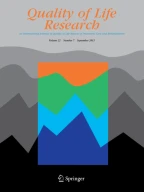Abstract
This study sought to validate World Wide Web-compliant software tools used to collect health-related quality of life (HRQOL) data, relative to pencil-and-paper collection. The RAND-36 general health survey and the Seattle Angina questionnaire (SAQ), a disease-specific functional status measure for patients with coronary artery disease, were each administered in paper and electronic format to 55 consecutive patients visiting the cardiology outpatient clinic of a public hospital. All eight sub-scale scores of the RAND-36 (interclass correlation coefficient range = 0.54–0.75, p < 0.01) and all five domains of the SAQ (interclass correlation coefficient range = 0.84–0.90, p < 0.01) collected using the software were significantly correlated with those collected using the paper version of questionnaires. Computer literacy, educational level, age, sex, and race were not significantly associated with the ability to successfully complete the computer-assisted questionnaire. Eighty-two percent of patients preferred the computer-assisted administration to paper, and 89% reported that they would feel comfortable using the software in the future without any technical assistance. This pilot study suggests that HRQOL measures can be reliably collected using software operating over the World Wide Web. Data collected in this manner are valid and of comparable quality to self-reported, HRQOL data obtained via paper survey.
Similar content being viewed by others
References
Patrick DL. Finding health-related quality of life outcomes sensitive to health-care organization and delivery. Med Care 1997; 35: NS49–NS57.
Revicki DA, Ehreth JL. Health-related quality-of-life assessment and planning for the pharmaceutical industry. Clin Therap 1997; 19: 1101–1115.
Rothwell PM, McDowell Z, Wong CK, Dorman PJ. Doctors and patients don't agree: Cross sectional study of patients' and doctors' perceptions and assessments of disability in multiple sclerosis. Br Med J 1997; 314: 1580–1583.
Patrick DL, Deyo RA. Generic and disease-specific measures in assessing health status and quality of life. Med Care 1989; 27: S217–S231.
Tsevat J, Weeks JC, Guadagnoli E, et al. Using health-related quality-of-life information: Clinical encounters, clinical trials, and health policy. J Gen Int Med 1994; 9: 576–582.
Guyatt GH, Jaeschke R, Feeny DH, Patrick DL. Measurements in clinical trials: Choosing the right approach. In: Spilker B (ed.), Quality of Life and Pharamcoeconomics in Clinical Trials, Philadelphia, PA: Lipincott-Raven, 1996.
Beller GA, Winters WL Jr, Carver JR, King III SB, McCallister BD, RL, P. 28th Bethesda Conference. Task Force 3: Guidelines for credentialling practicing physicians. J Amer Coll Cardiol 1997; 29: 1148–1162.
Anonymous. AMA launches physician accreditation program: Will AMAP become the gold standard? Health Care Business Digest 1988; 3: 35–43.
Soetikno R, Young HS, Keefe EB. Role of emerging technology in the era of cost containment. Am J Gastroenterol 1997; 92: 1038–1040.
Subramanian AK, McAfee AT, Getzingen JP. Use of the World Wide Web for multisite data collection. Acad Emer Med 1997; 4: 811–817.
Rind DM, Kohane IS, Szolovits P, Safran C, Chueh HC, Barnett GO. Maintaining the confidentiality of medical records shared over the Internet and the World Wide Web. Ann Inter Med 1997; 127: 138–141.
Taenzer PA, Speca M, Atkinson MJ, et al. Computerized quality-of-life screening in an oncology clinic. Cancer Pract 1997; 5: 168–175.
Doak CC, Doak LG, Root JH. Teaching Patients with Low Literacy Skills. 2nd edn., Philadelphia, PA: JB Lippincott, 1995.
Rand Health Sciences Program. Rand 36–item Health Survey 1.0. Santa Monica, CA: Rand Corporation, 1992.
Spertus JA, Winder JA, Dewhurst TA, Deyo RA, Fihn SD. Monitoring the quality of life in patients with coronary artery disease. Amer J Cardiol 1994; 74: 1240–1244.
Spertus JA, Winder JA, Dewhurst TA, et al. Development and evaluation of the Seattle Angina Questionnaire: A new functional status measure for coronary artery disease. J Amer Coll Cardiol 1995; 25: 333–341.
Deyo RA, Diehr P, Patrick DL. Reproducibility and responsiveness of health status measures: Statistics and strategies for evaluation. Controlled Clin Trials 1991; 12: 142S-158S.
Weinberger M, Oddone EZ, Samsa GP, Landsman PB. Are health-related quality of life measures affected by the mode of administration? J Clin Epidemiol 1996; 49: 135–140.
Radosevich DM, Werni TL. A Practical Guidebook for Implementing, Analyzing, and Reporting Outcomes Measurements, Health Outcomes Institute., 1998.
Ellwood P. Outcomes management: A technology of patient experience. N Engl J Med 1988; 318: 1550–1556.
Rights and permissions
About this article
Cite this article
Bliven, B.D., Kaufman, S.E. & Spertus, J.A. Electronic collection of health-related quality of life data: Validity, time benefits, and patient preference. Qual Life Res 10, 15–21 (2001). https://doi.org/10.1023/A:1016740312904
Issue Date:
DOI: https://doi.org/10.1023/A:1016740312904
